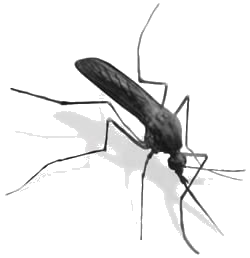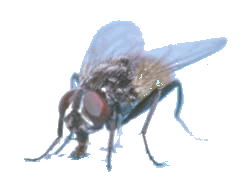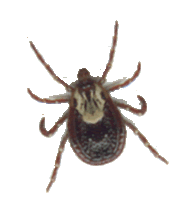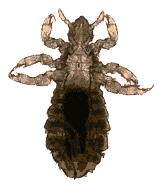Bugs that Bite: Interesting Facts & Necessary Precautions on the Insects That Crave You
by SixWise.com
With summer fast approaching, people aren't the only ones eager
to come out of their winter hiding. Many insects actually hibernate through
the winter (others migrate to warmer climates), but come spring they begin
to show up in our homes, backyards and even, at times, on our bodies.
But some bugs are more than just unsightly guests--bugs that bite can
spur allergies, cause painful welts and even spread disease. Knowing the
facts about some of the most common biting bugs will help to keep these
inevitable invaders from spoiling your summer fun.
Mosquitoes
 Where
They're Found: Mosquitoes can be found all over the world--except
in Antarctica! Because they must have standing water to lay eggs, they're
often found around ponds, swampy areas, stream edges, drainage areas and
other damp, wet areas.
Where
They're Found: Mosquitoes can be found all over the world--except
in Antarctica! Because they must have standing water to lay eggs, they're
often found around ponds, swampy areas, stream edges, drainage areas and
other damp, wet areas.
Why They Bite: Mosquitoes bite to feed. After landing on your
skin, they insert their sharp, thin mouthpart called a proboscis into
you and suck your blood into their abdomen.
Risks: After a mosquito bites you, some saliva remains in the
wound, causing an immune response to occur. The bite will typically swell
and itch until your immune system can break down the saliva. There is
also the risk that mosquitoes can transmit West Nile Virus, a type of
encephalitis that can cause high fever, stiff neck, headache, confusion
and laziness/sleepiness. Though not common in the United States, dengue
fever, yellow fever and malaria can also be transmitted by mosquitoes.
How to Avoid and Prevent: If you're going to spend time outdoors,
wear long pants, socks and long sleeves. Mosquitoes can bite through thin
material, so you may want to spray a chemical-free (look for a non-toxic
variety that doesn't contain DEET) insect repellant on the outside
of your clothes. You may also want to apply it to exposed skin. One such
safe repellant is Lice
B Gone--it's a lice shampoo that contains no harmful pesticides
or irritating chemicals that doubles as a non-toxic insect repellant.
Some people also spray it outside to keep pests away when they're
entertaining. Dusk and dawn are peak mosquito hours, so take extra precautions
during these times.
Since mosquitoes lay eggs in standing water, you can reduce the number
of mosquitoes around your home by eliminating any standing water (flower
pots, birdbaths, pet water dishes, barrels and more can all be culprits).
Keep mosquitoes out of your home by installing tight-fitting screens into
all your windows and doors (and repairing any holes in existing ones).
Interesting Facts: Only female mosquitoes bite people (males feed
on plant juices), and their saliva contains anticoagulant proteins that
prevent your blood from clotting and make it easier for them to feed.
Houseflies
 Where
They're Found: Like mosquitoes, houseflies are found all over
the world, except in Antarctica and a few remote islands. They also like
to hang out near horse manure, garbage or exposed food.
Where
They're Found: Like mosquitoes, houseflies are found all over
the world, except in Antarctica and a few remote islands. They also like
to hang out near horse manure, garbage or exposed food.
Why They Bite: Houseflies don't actually bite, but because
they like to hover around garbage and sewage they can be one of the riskiest
insects to humans. They use a spongy part of their mouth to "sponge"
up their food and, because of the way they eat (and the fact that they
sit in places crawling with bacteria), they easily transmit diseases when
they come in contact with our food.
Risks: Typhus, dysentery, tuberculosis, poliomyelitis, cholera,
pinworms, hookworms and some tapeworms can all be transmitted by the housefly,
often via our food.
How to Avoid and Prevent: Proper sanitation is key to keeping
flies at bay. Dispose of garbage and any type of rotting vegetation often,
and be sure to keep food stored in covered containers. At social events
like picnics, use mesh covers to keep flies from resting on your food,
and keep flies out of your home by installing screens in your windows
and doors.
Interesting Facts: Deerflies, horseflies and black flies (sometimes called
gnats) are the ones that bite (to feed on blood, like mosquitoes), but
since more than 98 percent of the flies we catch in our homes are the
aptly named houseflies, we decided to include them instead!
Fleas
 Where
They're Found: Fleas are found all over the world. In the United
States, they are typically found on cats, dogs and other pets, but they
can also infest humans once they're brought indoors on a pet. Fleas
lay their eggs on pets or in the pet's bedding as well as in cracks
and crevices in floors. In homes with dogs, fleas are commonly found where
the pet eats and sleeps and near the base of furniture. In homes with
cats, fleas may be present in higher locations (tops of refrigerators,
cabinets, etc.) where the cat may have gone.
Where
They're Found: Fleas are found all over the world. In the United
States, they are typically found on cats, dogs and other pets, but they
can also infest humans once they're brought indoors on a pet. Fleas
lay their eggs on pets or in the pet's bedding as well as in cracks
and crevices in floors. In homes with dogs, fleas are commonly found where
the pet eats and sleeps and near the base of furniture. In homes with
cats, fleas may be present in higher locations (tops of refrigerators,
cabinets, etc.) where the cat may have gone.
Why They Bite: Fleas bite dogs, cats, humans and other animals
to feed on their blood. An adult flea feeds on blood more than once a
day.
Risks: Fleas can transmit diseases to humans; the most well-known
of these is the plague (in the 14th century the "Black Death"
killed some 25 million people in Europe!). While plague epidemics haven't
been reported in the United States since 1925, wild rodents in the western
states may carry the disease and a few cases of plague in humans occur
each year because of them. Murine typhus, which typically occurs in rats
and mice, can also be transmitted to humans by fleas (about 40 human cases
are reported in the United States each year).
Flea bites themselves are red and very itchy. On humans they typically
occur on the ankles and legs. Fortunately, the fleas typically found in
homes are "just a nuisance," according to Marcia Larkins, D.V.M.,
chief of the companion and wildlife drugs branch in the Food and Drug
Administration's Center for Veterinary Medicine. "They generally
cause a lot of itching and scratching. They may also cause some discomfort
due to possible allergic flea bite dermatitis."
How to Avoid and Prevent: Pets with fleas are typically treated
with chemical flea treatments or collars. However, conventional flea and
tick control products, including the popular sprays, collars, and bombs,
can be extremely hazardous to pets and the person applying them--some
even contain highly noxious nerve gas. We encourage you to read Double-Danger:
Fleas & Ticks and their Common Treatment Products for more information.
If you're looking for a safe flea (and tick) treatment for your
pets, Sixwise.com highly recommends Flea
'n Tick B Gone. Unlike the other flea and tick treatments on the market,
Flea 'n Tick B Gone does not contain harmful pesticides or chemicals,
such as DEET, pyrethrins, synthetic pyrethroids or permethrin, all of
which can be harmful and irritating to your pet, the person applying them
and our environment.
Once fleas are in your home, be sure to vacuum all carpets, floors and
upholstered furniture every day for at least several weeks (dispose of
the vacuum cleaner bag after each cleaning so the fleas don't crawl
out). This will go a long way toward getting rid of the fleas as quickly
as possible.
Interesting Facts: A female flea can eat 15 times her body weight
in blood in only one day!
Ticks
 Where
They're Found: Ticks are found all over the world and like to
live in woods, tall grass, weeds and brush.
Where
They're Found: Ticks are found all over the world and like to
live in woods, tall grass, weeds and brush.
Why They Bite: Like fleas, ticks bite animals to feed on their
blood.
Risks: Ticks can transmit many diseases to humans including Rocky
Mountain spotted fever, Lyme disease (a potentially serious bacterial
infection that causes a rash and flu-like symptoms including fatigue,
headache, stiffness or pain in neck, muscles and joints, fever and swollen
glands), babesiosis (Texas fever), ehrlichiosis, tularemia, Colorado tick
fever and Powassan (a form of encephalitis).
They can also cause tick paralysis, a condition in which neurotoxins
from the tick's saliva actually cause paralysis in the body. In extreme
cases, tick paralysis can also stop you from breathing.
How to Avoid and Prevent: Since ticks like to live in brush and
tall grass, avoid walking through these types of areas. If you do, wear
long pants tucked into your socks and long sleeves. After you walk in
an area that may contain ticks, inspect pets and family members closely
(ticks are most often found near the neck and scalp). Keeping your own
yard well maintained, trimmed and mowed will help to keep ticks away.
If you find a tick on your pet, the completely pesticide-free and safe
Flea
'n Tick B Gone can be sprayed directly onto the tick to help with
removal.
Interesting Facts: Ticks are not insects, they're arachnids
like mites, spiders and scorpions. Some species can go for years without
feeding!
Lice
 Where
They're Found: Lice are found worldwide. They like warm places and
live on human scalps. They can also hide in hairbrushes, furniture and
bedding.
Where
They're Found: Lice are found worldwide. They like warm places and
live on human scalps. They can also hide in hairbrushes, furniture and
bedding.
Why They Bite: Lice bite humans to feed on their blood.
Risks: Lice don't pose any serious risks to humans; however,
they do cause an extremely annoying itch that occurs when a person has
an allergic reaction to the lice saliva. If a person scratches too hard,
a secondary skin infection could develop.
How to Avoid and Prevent: No one is immune to catching head lice,
but children are most often affected because they come in close contact
with each other and may share brushes, barrettes and caps. Teaching your
child not to share such items may help to prevent lice.
|
Flea 'n Tick B Gone: The Natural and Safe Way to Beat Fleas,
Ticks and Other Pests
 Flea
'n Tick B Gone is an enzyme-based formula made naturally from plant
resources, so it's entirely free of the neurotoxic pesticides that
make up conventional flea and tick treatments. Flea 'n Tick
B Gone is: Flea
'n Tick B Gone is an enzyme-based formula made naturally from plant
resources, so it's entirely free of the neurotoxic pesticides that
make up conventional flea and tick treatments. Flea 'n Tick
B Gone is:
- 100% Pesticide Free
- Non-toxic
- Clinically proven to be highly effective
- A Great Value! Eliminates the need for collars, bombs, foggers,
powders, etc., and is economically priced
- Can also be used on bedding and pet areas of the home--Simply
lightly spray in these areas
- Reduces vet and medicinal costs
- Can safely be used as a preventive against fleas and ticks:
Regular use can naturally break life cycle of fleas
- Controls other in-home pests
- Reduces risk of infections, dermatitis and itching
- Safely removes fleas, ticks, lice and other pests
Read
more about Flea n' Tick B Gone Now!
|
Once a person has lice, the typical treatment is to use a chemical shampoo.
However, pesticide-based shampoos are dangerous. "Preparations like
Rid and Kwell ... are definitely toxic to people," says Dr. Andrew
Weil, MD. That's because they contain pediculicides, which are potent
pesticides and insecticides designed to poison lice, but that can be absorbed
directly into your child's scalp.
Because today's conventional lice treatments are both dangerous for the
chemicals they contain and increasingly ineffective due to lice developing
resistance to them, we strongly urge you to avoid the conventional lice
treatments!
After extensive review, we highly recommend you use Lice
B Gone™, a safe, non-toxic, 100 percent pesticide-free multi-enzyme
shampoo made from natural plant sources. This extra-strength formula has
been clinically proven to effectively remove lice and nits without harmful
pesticides or irritating chemicals.
It's also important to wash (or dry clean) all clothing and bedding
thoroughly. For items that can't be washed, put them into airtight
plastic bags for several weeks (the lice can't survive without a
human host for more than a few days). Also thoroughly vacuum all furniture
and carpets.
Interesting Facts: Contrary to the popular belief that lice like
"dirty hair," lice actually prefer clean, healthy scalps.
Bees,
Wasps and Hornets
Where They're Found: These insects live throughout the United
States and world. They may establish hives or nests in trees, shrubs,
sides of buildings, attics or in the ground.
Why They Bite: These insects bite to defend themselves if they're
disturbed or injured. Bees, in particular, are not aggressive and typically
don't sting unless they're disturbed (many stings happen when
people walking barefoot step on them).
Risks: Most stings result in local swelling, pain, itching and
redness. It's possible, but not common, for an infection to also
occur. However, for those who are allergic to the venom, a sting can result
in a life-threatening allergic reaction that can cause hives, difficulty
breathing and swallowing, hoarseness, swelling of the tongue, dizziness
and fainting. Emergency care is necessary in these cases. Because the
venom of each insect varies, it's possible to be allergic to a bee
sting but not to a wasp sting, and so on.
How to Avoid and Prevent: To avoid getting stung, don't walk
barefoot outside and use caution around hornet and wasp nests. Food and
sweet beverages can attract these insects, so keep these items covered
while outdoors and dispose of trash (in a covered bin) immediately. If
you see a bee, wasp or hornet, leave it alone. Swatting or disturbing
these insects will only agitate them.
Allergic reactions to stings are treated with epinephrine (adrenaline).
People who are allergic to stings can get a prescription for a self-injectable
device (Epi-Pen, ANA-Kit, etc.) that they can use to treat themselves
in the event they are stung. However, more than one dose is often needed,
so emergency help may still be called for.
Interesting Facts: If you're stung by a honeybee, which has
barbs on its stinger, the stinger will remain in your skin. The stinger
is connected to the bee's digestive system, and as the bee flies
away it gets torn out of the bee, causing the bee to die soon after. If
you're stung by a wasp, hornet or bumble bee, the stinger is not
left in your skin, and the insect is not harmed.
Recommended Reading
Lice:
A Surprisingly Widespread Problem
Double-Danger:
Fleas & Ticks and their Common Treatment Products
Sources
How
Mosquitoes Work
eNature.com
Fleas
FDA: Fighting
Fleas and Ticks
Wasp
and Bee Control